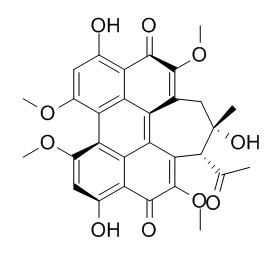Hypocrellin A
Hypocrellin A, an a natural perylene quinine photosensitizers (PSs), can chelate with heavy metal ions, including Au(III) and Pt(IV), to form a 1:2 complex. Hypocrellin A has light-induced antitumor,antifungal and antiviral activities, it also exerts immunomodulatory effects on MHC-restricted presentation of antigen.
Inquire / Order:
manager@chemfaces.com
Technical Inquiries:
service@chemfaces.com
Tel:
+86-27-84237783
Fax:
+86-27-84254680
Address:
1 Building, No. 83, CheCheng Rd., Wuhan Economic and Technological Development Zone, Wuhan, Hubei 430056, PRC
Providing storage is as stated on the product vial and the vial is kept tightly sealed, the product can be stored for up to
24 months(2-8C).
Wherever possible, you should prepare and use solutions on the same day. However, if you need to make up stock solutions in advance, we recommend that you store the solution as aliquots in tightly sealed vials at -20C. Generally, these will be useable for up to two weeks. Before use, and prior to opening the vial we recommend that you allow your product to equilibrate to room temperature for at least 1 hour.
Need more advice on solubility, usage and handling? Please email to: service@chemfaces.com
The packaging of the product may have turned upside down during transportation, resulting in the natural compounds adhering to the neck or cap of the vial. take the vial out of its packaging and gently shake to let the compounds fall to the bottom of the vial. for liquid products, centrifuge at 200-500 RPM to gather the liquid at the bottom of the vial. try to avoid loss or contamination during handling.
Journal of Molecular Liquids2021, 334:116014.
Molecules. 2013, 18(11):14105-21
Molecules.2020, 25(23):5556.
Heliyon.2022, e12337.
Current Analytical Chemistry2024, 20(8):599-610.
Acta Chromatographica2021, 00960.
Nutrients.2021, 13(12):4364.
Journal of Apiculture2019, 34(2):131-136
Curr Res Virol Sci.2022, 3:100019.
J Agric Food Chem.2023, 71(47):18510-18523.
Related and Featured Products
Bioorg Med Chem Lett. 2013 Oct 1;23(19):5317-24.
Internal heavy atom effect of Au(III) and Pt(IV) on hypocrellin A for enhanced in vitro photodynamic therapy of cancer.[Pubmed:
23978649]
METHODS AND RESULTS:
Hypocrellin A (HA), an a natural perylene quinine photosensitizers (PSs), can chelate with heavy metal ions, including Au(III) and Pt(IV), to form a 1:2 complex, which exhibits enhanced (1)O2 generation quantum yield through the increased intersystem crossing efficiency mediated by internal heavy atom effect. Besides, the chelate process greatly improved the water solubility of HA.
CONCLUSIONS:
Comparative studies with HA and complexes have demonstrated that the heavy-atom effect on HA molecules enhances the efficiency of in vitro photodynamic (PDT) efficacy.
Nanoscale. 2013 Dec 7;5(23):11910-8.
A new near infrared photosensitizing nanoplatform containing blue-emitting up-conversion nanoparticles and hypocrellin A for photodynamic therapy of cancer cells.[Pubmed:
24129918]
The utilization of up-conversion nanoparticles (UCNPs) for photodynamic therapy (PDT) has gained significant interest due to their unique ability to convert near infrared light to UV/visible light. Previous work mainly focused on the fabrication of green and red emitting UCNPs to load photosensitizers (PSs) for PDT.
METHODS AND RESULTS:
In this work, we firstly developed a new multifunctional nanoplatform combining blue-emitting UCNPs with blue-light excited PS (Hypocrellin A, HA) as a NIR photosensitizing nanoplatform for PDT of cancer cells. Tween 20 coated NaYbF4:Tm, Gd@NaGdF4 UCNPs (Tween 20-UCNPs) with strong blue up-conversion luminescence and good water dispersibility were prepared for use as PS carriers. The blue emission band matched well with the efficient absorption band of HA, thereby facilitating the resonance energy transfer from UCNPs to HA and then activating HA to produce singlet oxygen ((1)O2).
CONCLUSIONS:
The in vitro study showed that these Tween 20-UCNPs@HA complexes could efficiently produce (1)O2 to kill cancer cells under 980 nm NIR excitation. Moreover, these Gd(3+) and Yb(3+) containing nanoparticles also exhibited positive contrast effects in both T1 weighted magnetic resonance imaging (MRI) and computed tomography (CT) imaging, making them become a multifunctional platform for simultaneous PDT and bio-imaging.
Immune Netw. 2011 Dec;11(6):412-5.
Immunomodulatory Effects of Hypocrellin A on MHC-restricted Antigen Processing.[Pubmed:
22346783]
Hypocrellin A has gained much attention in recent years due to its light-induced antitumor, antifungal and antiviral activities.
METHODS AND RESULTS:
Here we report that Hypocrellin A exerts immunomodulatory effects on MHC-restricted presentation of antigen. Hypocrellin A inhibited class II-MHC restricted presentation of exogenous antigen, but not class I MHC-restricted presentation of exogenous antigen, in dendritic cells. Hypocrellin A also inhibited the cytosolic pathway of endogenous antigen presentation. However, Hypocrellin A did not inhibit the expression of class I and class II MHC molecules on dendritic cells (DCs), the phagocytic activity of DCs, or the H-2K(b)-restricted presentation of a synthetic peptide, SIINFEKL.
CONCLUSIONS:
These results show that Hypocrellin A differentially modulates the MHC-restricted antigen presentation pathways.
Spectrochim Acta A Mol Biomol Spectrosc. 2013 May 15;109:158-63.
Interactions of CT-DNA with Hypocrellin A and its Al(3+)-Hypocrellin A complex.[Pubmed:
23523758]
METHODS AND RESULTS:
In this study, the chelation of Hypocrellin A (HA) with Al(3+) in water solution has been synthesized, and the interactions of Hypocrellin A and Al(3+)-Hypocrellin A complex with calf thymus DNA are in detail compared by UV-vis and fluorescence spectroscopic techniques, circular dichroism spectroscopy and viscosity measurement.
CONCLUSIONS:
The experiment results suggest that Hypocrellin A and Al(3+)-Hypocrellin A complex both could bind to CT DNA by intercalation mode, and double helix of DNA was damaged. Moreover, Al(3+)-Hypocrellin A complex not only displays higher absorption at therapeutic window but also displays stronger binding affinity to CT DNA than HA.



